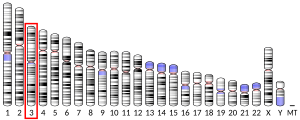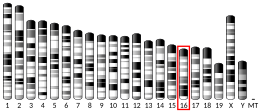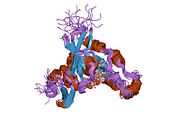PAK2
Serine/threonine-protein kinase PAK 2 is an enzyme that in humans is encoded by the PAK2 gene.[5][6]
PAK2 is one of three members of Group I PAK family of serine/threonine kinases.[7][8] The PAKs are evolutionary conserved.[9] PAK2 and its cleaved fragment localize in both the cytoplasmic or nuclear compartments. PAK2 signaling modulates apoptosis,[10] endothelial lumen formation,[11] viral pathogenesis,[12] and cancer including, breast,[13] hepatocarcinoma,[14] gastric [15] and cancer, at-large,[16] and, based on its kinase activity alone, peripheral nerve myelination during embryonic development. [17]
Discovery
[edit]The human PAK2 was identified as a downstream effector of Rac or Cdc42.[7][8]
Gene and spliced variants
[edit]The PAK2 gene is about 92.7-kb long. The gene contains 15 exons and generates three alternatively spliced transcripts - two of which code proteins of 524 amino acids and 221 amino acids, while the third one is a 371-bp non-coding RNA transcript(Gene from review) There are two transcripts generated from the murine PAK2 gene, a 5.7-kb transcript coding a 524 amino acids long polypeptide and a 1.2-kb long non-coding RNA transcript.
Protein domains
[edit]Similar to PAK1, PAK2 contains a p21-binding domain (PBD) and an auto-inhibitory domain (AID) and exists in an inactive conformation.[16]
The p21 activated kinases (PAK) are critical effectors that link Rho GTPases to cytoskeleton reorganization and nuclear signaling. The PAK proteins are a family of serine/threonine kinases that serve as targets for the small GTP binding proteins, CDC42 and RAC1, and have been implicated in a wide range of biological activities. The protein encoded by this gene is activated by proteolytic cleavage during caspase-mediated apoptosis, and may play a role in regulating the apoptotic events in the dying cell.[18]
Function
[edit]The p21 activated kinases (PAK) are critical effectors that link Rho GTPases to cytoskeleton reorganization and nuclear signaling. The PAK proteins are a family of serine/threonine kinases that serve as targets for the small GTP binding proteins, CDC42 and RAC1, and have been implicated in a wide range of biological activities. The protein encoded by this gene is activated by proteolytic cleavage during caspase-mediated apoptosis, and may play a role in regulating the apoptotic events in the dying cell.[19] Finally, while both PAK 1 and PAK 2 proteins have been shown to be elevated during the embryonic phase, PAK 2 kinase activity specifically has been demonstrated to be a requirement during the myelenation of developing nerves. [17]
Upstream activators
[edit]PAK2 kinase activity is stimulated by transforming growth factor β in fibroblasts,[20] by proteinase inhibitor alpha2-macroglobulin binding to GRP78 in prostate cancer cells,[21] by its phosphorylation by AMP-activated protein kinase in stem and cancer cells [22] and eryptosis.[23] PAK2 is cleaved through activated caspase-3 in fibroblast and cancer cells exposed to ultraviolet,[24] hyperosmotic shock,[25] and ionizing radiation.[26]
Inhibitors
[edit]The levels of PAK2 activation in experimental systems are inhibited by synthetic PAK-inhibitors and miRs. For example, FRAX1036 differentially inhibits PAK2 and PAK1 activities;[27] FRAX597 suppresses PAK2 activity in neurofibromatosis type 2 (NF2)-associated tumorigenesis;[28] and miR-23b and miR-137 inhibits PAK2 expression in tumor cells.[29][30] Insulin stimulation of neuronal cells also antagonizes PAK2 kinase activity, leading to an increased glucose uptake.[31]
Downstream targets
[edit]PAK2-mediated phosphorylation of merlin at S518 modulates its tumor suppressor activity,[32] c-Jun phosphorylation at T2, T8, T89, T93 and T286 contributes to the growth of growth factor-stimulated melanoma cells,[33] Caspase-7 phosphorylation at S30, T173 and S239 inhibits apoptotic activity in breast cancer cells,[13] Paxillin phosphorylation at S272 and S274 activates ADAM10 protease,[34] and STAT5 phosphorylation at S779 modulates BCL-ABL-mediated leukemogenesis.[35] PAK2 activity negatively regulates the function and expression of c-Myc: PAK2 phosphorylation of c-Myc at T358-S373-T400 inhibits its transactivation function [36] and PAK2 depletion stimulates c-Myc expression during granulocyte-monocyte lineage.[37]
Notes
[edit]
The 2016 version of this article was updated by an external expert under a dual publication model. The corresponding academic peer reviewed article was published in Gene and can be cited as: Rakesh Kumar, Rahul Sanawar, Xiaodong Li, Feng Li (19 December 2016). "Structure, biochemistry, and biology of PAK kinases". Gene. 605: 20–31. doi:10.1016/J.GENE.2016.12.014. PMC 5250584. PMID 28007610. |
References
[edit]- ^ a b c GRCh38: Ensembl release 89: ENSG00000180370 – Ensembl, May 2017
- ^ a b c GRCm38: Ensembl release 89: ENSMUSG00000022781 – Ensembl, May 2017
- ^ "Human PubMed Reference:". National Center for Biotechnology Information, U.S. National Library of Medicine.
- ^ "Mouse PubMed Reference:". National Center for Biotechnology Information, U.S. National Library of Medicine.
- ^ Martin GA, Bollag G, McCormick F, Abo A (May 1995). "A novel serine kinase activated by rac1/CDC42Hs-dependent autophosphorylation is related to PAK65 and STE20". The EMBO Journal. 14 (9): 1970–8. doi:10.1002/j.1460-2075.1995.tb07189.x. PMC 398296. PMID 7744004.
- ^ Knaus UG, Morris S, Dong HJ, Chernoff J, Bokoch GM (July 1995). "Regulation of human leukocyte p21-activated kinases through G protein--coupled receptors". Science. 269 (5221): 221–3. Bibcode:1995Sci...269..221K. doi:10.1126/science.7618083. PMID 7618083.
- ^ a b Knaus UG, Morris S, Dong HJ, Chernoff J, Bokoch GM (July 1995). "Regulation of human leukocyte p21-activated kinases through G protein--coupled receptors". Science. 269 (5221): 221–3. Bibcode:1995Sci...269..221K. doi:10.1126/science.7618083. PMID 7618083.
- ^ a b Manser E, Chong C, Zhao ZS, Leung T, Michael G, Hall C, Lim L (October 1995). "Molecular cloning of a new member of the p21-Cdc42/Rac-activated kinase (PAK) family". The Journal of Biological Chemistry. 270 (42): 25070–8. doi:10.1074/jbc.270.42.25070. PMID 7559638.
- ^ Kumar A, Molli PR, Pakala SB, Bui Nguyen TM, Rayala SK, Kumar R (July 2009). "PAK thread from amoeba to mammals". Journal of Cellular Biochemistry. 107 (4): 579–85. doi:10.1002/jcb.22159. PMC 2718766. PMID 19350548.
- ^ Bokoch GM (August 1998). "Caspase-mediated activation of PAK2 during apoptosis: proteolytic kinase activation as a general mechanism of apoptotic signal transduction?". Cell Death and Differentiation. 5 (8): 637–45. doi:10.1038/sj.cdd.4400405. PMID 10200518.
- ^ Davis GE, Koh W, Stratman AN (December 2007). "Mechanisms controlling human endothelial lumen formation and tube assembly in three-dimensional extracellular matrices". Birth Defects Research. Part C, Embryo Today. 81 (4): 270–85. doi:10.1002/bdrc.20107. PMID 18228260.
- ^ Van den Broeke C, Radu M, Chernoff J, Favoreel HW (March 2010). "An emerging role for p21-activated kinases (Paks) in viral infections". Trends in Cell Biology. 20 (3): 160–9. doi:10.1016/j.tcb.2009.12.005. PMC 6489496. PMID 20071173.
- ^ a b Li X, Wen W, Liu K, Zhu F, Malakhova M, Peng C, Li T, Kim HG, Ma W, Cho YY, Bode AM, Dong Z, Dong Z (June 2011). "Phosphorylation of caspase-7 by p21-activated protein kinase (PAK) 2 inhibits chemotherapeutic drug-induced apoptosis of breast cancer cell lines". The Journal of Biological Chemistry. 286 (25): 22291–9. doi:10.1074/jbc.M111.236596. PMC 3121375. PMID 21555521.
- ^ Sato M, Matsuda Y, Wakai T, Kubota M, Osawa M, Fujimaki S, Sanpei A, Takamura M, Yamagiwa S, Aoyagi Y (June 2013). "P21-activated kinase-2 is a critical mediator of transforming growth factor-β-induced hepatoma cell migration". Journal of Gastroenterology and Hepatology. 28 (6): 1047–55. doi:10.1111/jgh.12150. PMID 23425030. S2CID 23620441.
- ^ Gao C, Ma T, Pang L, Xie R (March 2014). "Activation of P21-activated protein kinase 2 is an independent prognostic predictor for patients with gastric cancer". Diagnostic Pathology. 9: 55. doi:10.1186/1746-1596-9-55. PMC 3975179. PMID 24621074.
- ^ a b Kumar R, Li DQ (2016). "PAKs in Human Cancer Progression: From Inception to Cancer Therapeutic to Future Oncobiology". Advances in Cancer Research. 130: 137–209. doi:10.1016/bs.acr.2016.01.002. ISBN 978-0-12-804789-7. PMID 27037753.
- ^ a b Hu B, Moiseev D, Schena I, Faezov B, Dunbrack R, Chernoff J, Li J (2024). "PAK2 is necessary for myelination in the peripheral nervous system". Brain. 147 (5): 1809–1821. doi:10.1093/brain/awad413. PMC 11068108. PMID 38079473. Retrieved 2024-08-07.
- ^ "Entrez Gene: PAK2 p21 (CDKN1A)-activated kinase 2".
- ^ "Entrez Gene: PAK2 p21 (CDKN1A)-activated kinase 2".
- ^ Wilkes MC, Murphy SJ, Garamszegi N, Leof EB (December 2003). "Cell-type-specific activation of PAK2 by transforming growth factor beta independent of Smad2 and Smad3". Molecular and Cellular Biology. 23 (23): 8878–89. doi:10.1128/mcb.23.23.8878-8889.2003. PMC 262664. PMID 14612425.
- ^ Misra UK, Deedwania R, Pizzo SV (July 2005). "Binding of activated alpha2-macroglobulin to its cell surface receptor GRP78 in 1-LN prostate cancer cells regulates PAK-2-dependent activation of LIMK". The Journal of Biological Chemistry. 280 (28): 26278–86. doi:10.1074/jbc.M414467200. PMC 1201553. PMID 15908432.
- ^ Banko MR, Allen JJ, Schaffer BE, Wilker EW, Tsou P, White JL, Villén J, Wang B, Kim SR, Sakamoto K, Gygi SP, Cantley LC, Yaffe MB, Shokat KM, Brunet A (December 2011). "Chemical genetic screen for AMPKα2 substrates uncovers a network of proteins involved in mitosis". Molecular Cell. 44 (6): 878–92. doi:10.1016/j.molcel.2011.11.005. PMC 3246132. PMID 22137581.
- ^ Zelenak C, Föller M, Velic A, Krug K, Qadri SM, Viollet B, Lang F, Macek B (April 2011). "Proteome analysis of erythrocytes lacking AMP-activated protein kinase reveals a role of PAK2 kinase in eryptosis". Journal of Proteome Research. 10 (4): 1690–7. doi:10.1021/pr101004j. PMID 21214270.
- ^ Tang TK, Chang WC, Chan WH, Yang SD, Ni MH, Yu JS (September 1998). "Proteolytic cleavage and activation of PAK2 during UV irradiation-induced apoptosis in A431 cells" (PDF). Journal of Cellular Biochemistry. 70 (4): 442–54. doi:10.1002/(sici)1097-4644(19980915)70:4<442::aid-jcb2>3.3.co;2-n. PMID 9712143.
- ^ Chan WH, Yu JS, Yang SD (March 1999). "PAK2 is cleaved and activated during hyperosmotic shock-induced apoptosis via a caspase-dependent mechanism: evidence for the involvement of oxidative stress". Journal of Cellular Physiology. 178 (3): 397–408. doi:10.1002/(SICI)1097-4652(199903)178:3<397::AID-JCP14>3.0.CO;2-2. PMID 9989786. S2CID 35684065.
- ^ Roig J, Traugh JA (October 1999). "p21-activated protein kinase gamma-PAK is activated by ionizing radiation and other DNA-damaging agents. Similarities and differences to alpha-PAK". The Journal of Biological Chemistry. 274 (44): 31119–22. doi:10.1074/jbc.274.44.31119. PMID 10531298.
- ^ Ong CC, Gierke S, Pitt C, Sagolla M, Cheng CK, Zhou W, et al. (April 2015). "Small molecule inhibition of group I p21-activated kinases in breast cancer induces apoptosis and potentiates the activity of microtubule stabilizing agents". Breast Cancer Research. 17 (1): 59. doi:10.1186/s13058-015-0564-5. PMC 4445529. PMID 25902869.
- ^ Licciulli S, Maksimoska J, Zhou C, Troutman S, Kota S, Liu Q, Duron S, Campbell D, Chernoff J, Field J, Marmorstein R, Kissil JL (October 2013). "FRAX597, a small molecule inhibitor of the p21-activated kinases, inhibits tumorigenesis of neurofibromatosis type 2 (NF2)-associated Schwannomas". The Journal of Biological Chemistry. 288 (40): 29105–14. doi:10.1074/jbc.M113.510933. PMC 3790009. PMID 23960073.
- ^ Pellegrino L, Krell J, Roca-Alonso L, Stebbing J, Castellano L (2012). "MicroRNA-23b regulates cellular architecture and impairs motogenic and invasive phenotypes during cancer progression". Bioarchitecture. 3 (4): 119–24. doi:10.4161/bioa.26134. PMC 4201606. PMID 24002530.
- ^ Hao S, Luo C, Abukiwan A, Wang G, He J, Huang L, Weber CE, Lv N, Xiao X, Eichmüller SB, He D (December 2015). "miR-137 inhibits proliferation of melanoma cells by targeting PAK2". Experimental Dermatology. 24 (12): 947–52. doi:10.1111/exd.12812. PMID 26186482. S2CID 29618231.
- ^ Varshney P, Dey CS (July 2016). "P21-activated kinase 2 (PAK2) regulates glucose uptake and insulin sensitivity in neuronal cells". Molecular and Cellular Endocrinology. 429: 50–61. doi:10.1016/j.mce.2016.03.035. PMID 27040307. S2CID 34525487.
- ^ Rong R, Surace EI, Haipek CA, Gutmann DH, Ye K (November 2004). "Serine 518 phosphorylation modulates merlin intramolecular association and binding to critical effectors important for NF2 growth suppression". Oncogene. 23 (52): 8447–54. doi:10.1038/sj.onc.1207794. PMID 15378014. S2CID 13480894.
- ^ Li T, Zhang J, Zhu F, Wen W, Zykova T, Li X, Liu K, Peng C, Ma W, Shi G, Dong Z, Bode AM, Dong Z (May 2011). "P21-activated protein kinase (PAK2)-mediated c-Jun phosphorylation at 5 threonine sites promotes cell transformation". Carcinogenesis. 32 (5): 659–66. doi:10.1093/carcin/bgq271. PMC 3086698. PMID 21177766.
- ^ Lee JH, Wittki S, Bräu T, Dreyer FS, Krätzel K, Dindorf J, Johnston IC, Gross S, Kremmer E, Zeidler R, Schlötzer-Schrehardt U, Lichtenheld M, Saksela K, Harrer T, Schuler G, Federico M, Baur AS (February 2013). "HIV Nef, paxillin, and Pak1/2 regulate activation and secretion of TACE/ADAM10 proteases". Molecular Cell. 49 (4): 668–79. doi:10.1016/j.molcel.2012.12.004. PMID 23317503.
- ^ Berger A, Hoelbl-Kovacic A, Bourgeais J, Hoefling L, Warsch W, Grundschober E, Uras IZ, Menzl I, Putz EM, Hoermann G, Schuster C, Fajmann S, Leitner E, Kubicek S, Moriggl R, Gouilleux F, Sexl V (March 2014). "PAK-dependent STAT5 serine phosphorylation is required for BCR-ABL-induced leukemogenesis". Leukemia. 28 (3): 629–41. doi:10.1038/leu.2013.351. PMC 3948164. PMID 24263804.
- ^ Huang Z, Traugh JA, Bishop JM (February 2004). "Negative control of the Myc protein by the stress-responsive kinase Pak2". Molecular and Cellular Biology. 24 (4): 1582–94. doi:10.1128/mcb.24.4.1582-1594.2004. PMC 344192. PMID 14749374.
- ^ Zeng Y, Broxmeyer HE, Staser K, Chitteti BR, Park SJ, Hahn S, Cooper S, Sun Z, Jiang L, Yang X, Yuan J, Kosoff R, Sandusky G, Srour EF, Chernoff J, Clapp DW (May 2015). "Pak2 regulates hematopoietic progenitor cell proliferation, survival, and differentiation". Stem Cells. 33 (5): 1630–41. doi:10.1002/stem.1951. PMC 4409559. PMID 25586960.
External links
[edit]- PAK2 Info with links in the Cell Migration Gateway Archived 2014-12-11 at the Wayback Machine
- Overview of all the structural information available in the PDB for UniProt: Q13177 (Serine/threonine-protein kinase PAK 2) at the PDBe-KB.













